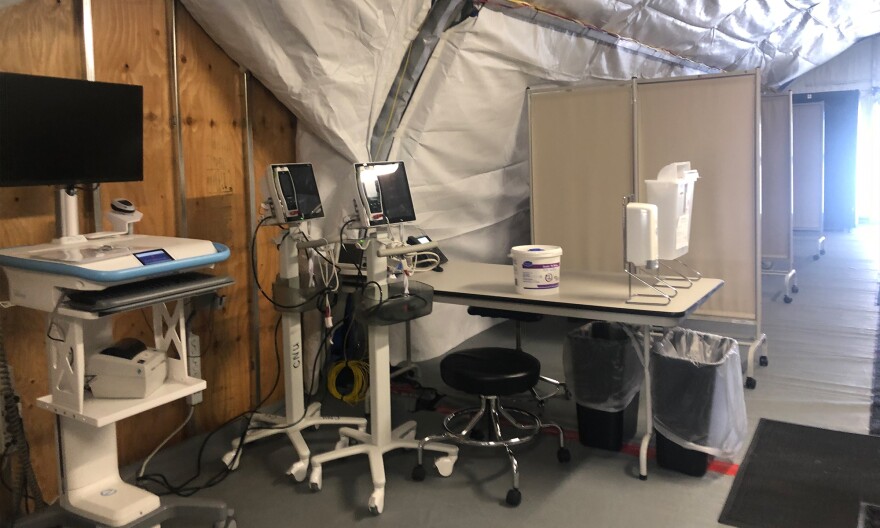The shortage of personal protective equipment used by health workers has been a nationwide problem during the novel coronavirus pandemic. Providers are grappling with the challenges presented to them and they're looking at various other ways to protect themselves and the community.
Emergency room doctors are accustomed to encountering dire medical situations on a regular basis. But the COVID-19 pandemic is presenting new challenges.
“We're waiting for the other shoe to drop. We know that the storm is coming,” said Dr. Cari Croghan, an ER physician who practices at Renown Health.
Croghan said the shortage of personal protective equipment, or PPE, experienced nationwide, and also in her department, worries her.
“So the masks, hoods, gloves and face masks that all of us need to wear, as well as some of the patients who may be infectious... there just simply isn't enough to go around,” Croghan said. “Right now, I think we're just on standby with the rationing, reusing and repurposing [of PPE] until better answers come along.”
According to the World Health Organization, or WHO, the shortage of PPEs can lead to health workers being ill-equipped or to misuse what’s available, which can put their lives at risk.
Since the pandemic, the CDC has issued updated guidance on how to utilize PPEs during the crisis, for example, by extending the use and limited reuse of N95 masks or using substitutions.
“Instead of using a higher level barrier, like the N95, there are [other] surgical masks available. So at least that does something, but it certainly isn't the gold standard for what we're dealing with for droplet protection,” Croghan explained. "We're really only supposed to use that one-to-one and we're having to use one N95 mask for days.”
Labor groups like National Nurses United have criticized the CDC for rolling back standards that providers are accustomed to for the use of N95 masks, saying that they’re at increased risks with the changes.
But some medical professionals agree with the CDC guidelines issued during this pandemic. Dr. Trudy Larson is a professor and dean at the University of Reno School of Community Health Sciences. She’s practiced medicine for nearly four decades and is trained as a pediatric infectious disease specialist. She said the federal guidelines are based on what’s been learned from the prevention of other infectious diseases.
“The evidence suggests that there are many ways to reuse equipment that is safe for the health care professional,” Larson said. “The CDC has spent decades looking at how to best protect workers.”
Larson said that medical providers are trained in a medical model, which focuses on treating individual patients when the scarcity of medical supplies is not a problem.
“The model that we're used to operating on is every patient gets everything they need. That's what's comfortable and what's usual for most health care providers,” Larson said.” We are no longer able to function in that fashion.”
In a pandemic, Larson said those providers have to shift gears to a different model: a public health model, in which more of the population is sick and there are shortages.
“When resources become scarce, whether it's a mass casualty effect or if it's a massive infectious disease like we have right now,” Larson explained, “there's different ways to use and reuse equipment that still provides the safety that's necessary to keep health professionals safe.”
Larson said she understands why the shortage has created fear in the medical community.
“This is a new virus,” Larson said. “We know it can cause death in some patients. Its spread has been more rapid than we expected and we are having to cope with large numbers of very sick people, and in the process, have to make adjustments for how we take care of them.”
Since Croghan is on the frontlines as an ER doctor, she said she and some of her colleagues are taking the personal precautions they can.
“I think everyone's taking it quite seriously. We don't want to bring anything home to our families, nor do we want to bring anything to the hospital from home,” Croghan explained. “We're doing a lot of clothes juggling and sterilization; getting naked in our garages and wearing the things to work that can be, frankly, thrown away if necessary.”
Dr. Elena Mnatsakanyan is the Northern Nevada Medical Center director of quality, risk management and infection control. She said she’s seeing community members step in to plug some holes left by supply shortages.
“Many businesses are actually using surgical masks, N95s, sanitizers, and that's what they are willing to provide to hospitals,” Mnatsakanyan said. “We get a lot of stuff from dental offices, from local small businesses [and] from physician offices.”
According to the CDC, COVID-19 is spread by respiratory droplets produced when an infected person coughs or sneezes.
To stem the spread of infection, Mnatsakanyan said Northern Nevada Medical Center has increased the number of rooms at the hospital to negative pressure airflow areas with special vents and filtration systems.
“Negative airflow means that air from that room doesn't go into the hallway [or] into the general hospital, but everything goes out,” Mnatsakanyan explained. “That way, you prevent any spread of the air — with possible viruses or bacterias — into the general hallways. You keep that area protected basically.”
The entire ICU and another medical unit have now been converted to negative airflow to prepare for treating COVID-19 patients.

One other way hospitals in Washoe — including Renown, Northern Nevada Medical Center and St. Mary’s Regional Medical Center — are responding to the coronavirus is by setting up alternative care sites. These medical tents enable providers to screen and evaluate some patients away from the main ER, with the goal of preventing the spread of infection.
But since critical shortages have not been abated, medical providers continue to take on the additional burden of making critical adjustments that could threaten their health and safety.






